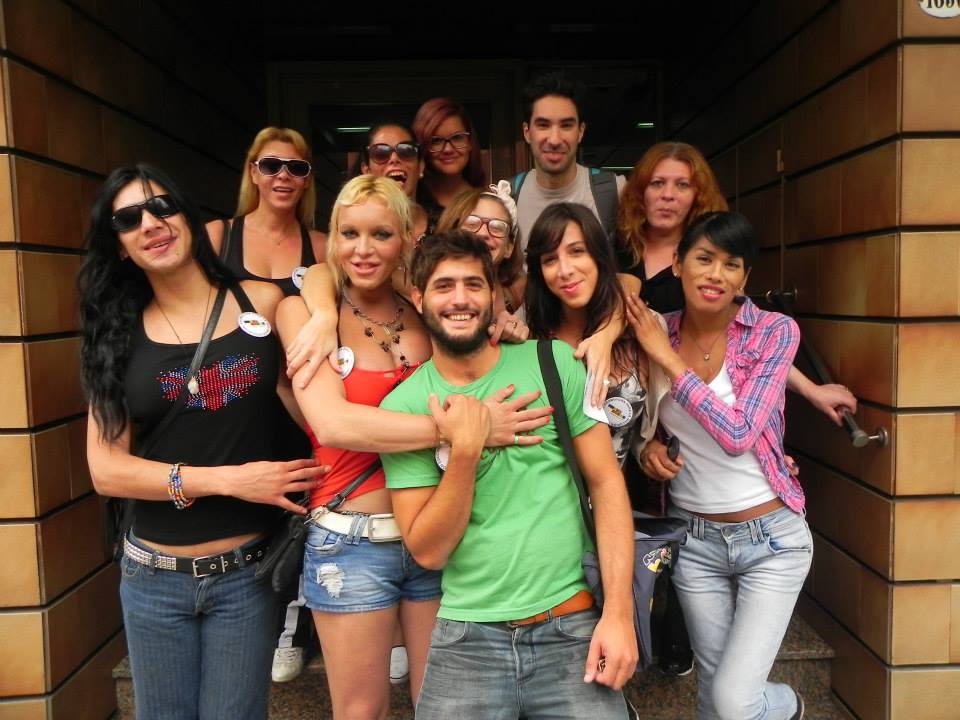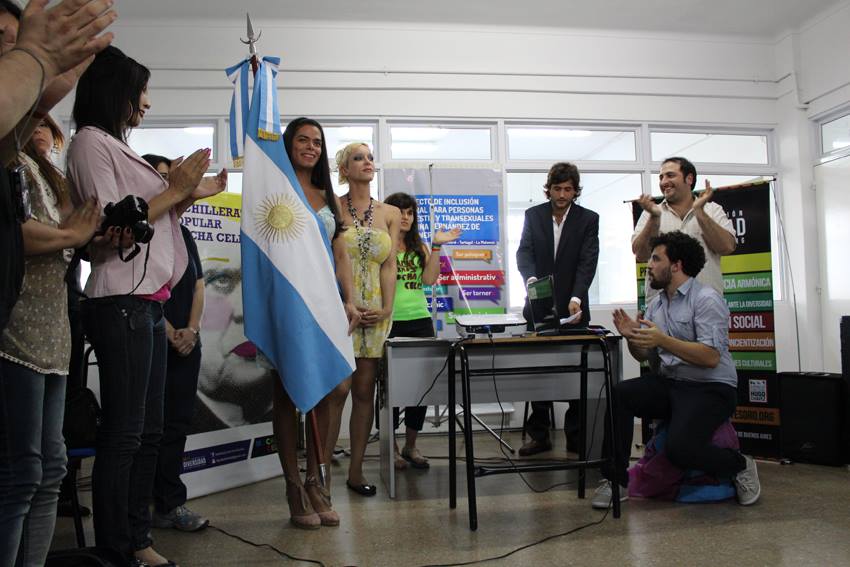Transsexual, transgender, transvestite – still a largely misunderstood world.

Last month the stunning and too often blithely described “androgynous model” Andrej Pejic re-introduced herself as Andreja, following her gender transition surgery. Andreja became the name to chase back in 2011 when she elevated cross-dressing to couture walking in both men’s and women’s shows at fashion week. Identifying herself under the bite-size commercial term: “unisex”, Andreja re-ignited the trend for androgyny and went on to work for a raft of top designers. Now 22, she has found the confidence to fully identify as a trans woman. It is a very powerful step for an industry who have embraced androgyny to the point of mundanity; it seems all well and sexy if you’re a girl and look like a boy, or a boy and look like a girl, but transsexual women and men are far less “in fashion”.
Andreja’s announcement comes in a year of landmark events for the trans community. Comedian Eddie Izzard last week spoke to The Independent about the prejudice he has faced as a transvestite, and how the strength he used to overcome it will help empower him in his pledge for London Mayor in 2020. Actress Laverne Cox, who appeared on the cover of Time magazine, has just made history as the first openly trans woman to be nominated for an Emmy for her role as trans inmate Sophia in Orange is the New Black. And earlier this year, Thomas Neuwirth won Eurovision dressed as his drag alter-ego, Conchita Wurst.
While there is a lot of positive movement in the trans world to celebrate, the fact is one in four young trans people in the UK experience physical abuse at school, and three quarters of young trans people have self-harmed.
The Gay Star reported 78 murders of trans people in 2013, with many cases involving mutilation and torture. Prostitution is also rife within the community, due to high unemployment rates and young people being bullied out of school, and they face an overwhelmingly low life-expectancy due to sexually transmitted diseases, which are the result of a lack of trans-specific sex education. So despite the good press, there are still pressing issues to address.
I have spent the last six months living in Buenos Aires, the so-called “Trans Capital of the World”. The official stats claim there are 10,000 trans people living in the city, but off the record the number is far greater. The state policies towards trans people in Argentina are the most progressive of any government, resulting in open and positive attitudes in society towards trans people. Through speaking to trans activists and government officials working on trans rights issues, I have realised how different it is here to the UK, and how much we can learn from this open, honest and pragmatic society.

Students at Mocha Celis School
In 2008, Argentine trans activist Lohana Berkins started a textile corporation called Nadia Echazu in one of the provinces of Argentina, where young trans people are given apprenticeships in the textile industry, as well as accommodation and healthcare. Then in 2011, the world’s first trans school was opened in Buenos Aires, inspired by Lohana’s work. Named Mocha Celis, after an illiterate transvestite prostitute who was allegedly murdered by a federal police officer in the 90s, the school has 25 teachers (half of whom are trans), and 90 pupils between the ages of 16 and 77! Often subjected to bullying and discrimination at school, it’s common for trans people to leave education early. “Schools do not respect students who have chosen to change their names to reflect their new identities,” said Francisco Quinones Cuartas, the founder of Mocha Celis:
“They insist on calling the students by the names on their official IDs, and they insist on the students using the toilets of their birth gender, not their new gender. There have been instances around the world where students were afraid to go to the boys’ toilets because they were attacked.”
The work minister in Buenos Aires gives each student at Mocha Celis money to help with travel and living costs, and a new government program offers extracurricular workshops, initiated by the students, including hairdressing, dressmaking and business management. The school acknowledges that many of its students need prostitution to earn money and to survive. So rather than ignoring the problem, the founder and the teachers take practical steps to help such as free regular health checks and late-afternoon classes to fit in with the students’ schedules. While of course prostitution is not encouraged – far from it – both the school and the government are wise to the reality, and through education and policy are working towards social inclusion of trans people, so that they may be integrated into society and have the same job prospects as everyone else. Inevitably, the road is long.
In 2012, the very left-wing government introduced the Gender Identity Law, which denotes that any person in Argentina can change their official, legal identity from male to female and vice versa without any medical sign off, surgery, or hormone treatment. This privilege is unique to Argentina, and is the reason hundreds of trans people all over the Americas are saving up to move to the country. The Head of Congress and author of the Gender Identity bill, Juliana di Tullio told me, “The gender ID card law was passed without any debate in Congress — it was unanimous. Even the people who voted against the gay marriage law in 2010 were in favour of the transgender ID card law.” Trans rights are a priority in Argentina both for the state and for society.

Students at Mocha Celis School
In my research, I also met with Peruvian trans woman Cristina Idania Rengifo Pinchi, the first trans person in the world to work for a federal government. “Buenos Aires is paradise for the trans community,” she told me. “But the difference between Argentina and the rest of the world is that the trans people here fight hard for their own rights. We are the protagonists of our situation, we are the owners of our fight.” Though Argentina is leading the way in policy and social attitude, Cristina points out that the fight is ongoing. “We have to fight for these laws to stay in society. In Spain, the government wants to erase their gender laws and their gay marriage law. We have to fight all the time to keep society open. Each trans person must take responsibility and fight for their role in society.”
Cristina was part of a huge public campaign in the late 90s to incorporate trans issues into sex education:
“Through this campaign, we went to schools and taught basic sex education in the classrooms; how to use condoms, what precautions to take to avoid contracting HIV. Just being there, as trans people, in the classroom, just showing ourselves, helped to educate. Before that, we were invisible, we existed in the shadows.”
Cristina is also a mentor to young trans people. “First you have to deal with your family, before school or society, the family is the first hurdle. Young trans people are often kicked out of their family homes, so in our community, we have a system where an older trans person, like a mentor, opens their house to the young person and helps them through.”
She started taking hormones at 12 years old. Now, at just 5’4″ with long blonde hair stopping just above a round bum, Cristina is extremely feminine for a trans woman. Which may sound impolite, but it’s a fact that, ironically, isolates her within the trans community. “I’m considered very feminine because I’m petite,” she explains. “I have some difficulties with the community, because some trans people are much bigger and taller and more masculine. They fight with me and say, ‘Oh, it’s so easy for you — you look like a woman.’ I understand this, but I say to them, ‘I chose this life, too, just like you.’”
When I thank Cristina for the interview and tell her she is an inspiring woman to me, she corrects me, “trans-woman. I am not a woman. I feel like a woman inside and I have had years of extremely painful surgery and emotional struggle to look and feel the way I do now, but I was born a boy and now I am a trans woman.”
The terminology is very important to her. As it is to Andreja Pejic, who went from calling herself “unisex” to coming out publicly as a trans woman. Many trans people are proud to be just that, trans people, and while British society stumbles over the three T’s: transsexual (a person who has undergone gender reassignment surgery to physically change their sex), transgender (a person who identifies or expresses themselves with the opposite gender to their birth), transvestite (usually a heterosexual man who dresses as a woman. NB: a transvestite isn’t the same as a drag queen!). It is important to learn the meanings of these words, and to use them correctly.
So how does this relate to fashion? Though London, and particularly the fashion scene has always celebrated this kind of diversity and there is an exciting trans culture in the city, the reality for young trans people in the UK and the majority of trans adults is much less glamorous. Fashion magazines on the left of the industry feature the likes of Andreja Pejic and Carmen Carrera, but it is too often the individual that they are celebrating, whose status as a media novelty overshadows all other issues around identity and struggle.
Fashion could use its influence to start representing the trans population in campaigns and editorial, not just for the catwalk. Because what is a ‘womenswear’ report going to do for a young trans person still at school, unable to identify which pages they should fit into? And while the beauty pages talk of skincare and bikini waxes, where can a young trans person look for advice? We look to fashion for inspiration, so it should inspire everyone.
***
 |
Sarah Raphael Contributor Sarah is a freelance journalist. Sarah writes about culture and fashion for publications including The Guardian, Vice, Grazia and i-D, where she was deputy editor. Find Sarah on Twitter @sarah_raphael |

